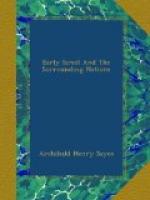At the same time, Midianitish supremacy did not mean the destruction of the Moabite kingdom. Moab was still governed by its own kings, tributary vassals though they were to the foreigner. One of them, Eglon, made himself master of southern Palestine shortly after the Israelitish conquest of the country, and was murdered by the Benjamite Ehud. Between Moab and Judah there was, as might be expected from their geographical position, constant intercourse. A Moabitess was the ancestress of David, and it was to the court of the King of Moab that David entrusted his parents when hard pressed by Saul. Possibly the Moabite prince was not ill pleased to befriend the enemy of his own enemy, the King of Israel.
It had been better for the Moabites, however, had David never lived to succeed Saul. The conquest of the Philistines by his troops was followed by the conquest of Moab. The vanquished people were decimated, every second man being mercilessly slain. So thoroughly was the country subdued that it was more than a century before it ventured to break away from its Israelitish master. After the disruption of Solomon’s heritage it fell to the share of the northern kingdom, though native kings once more sat upon its throne. Now and again they revolted, to be brought back to obedience, however, when Israel recovered its strength. Such was the case when Omri founded his dynasty at Samaria; Moab again became a dependency of the Israelitish monarch, and its ruler was forced to pay tribute and homage to his over-lord. The tribute consisted in sheep, or rather in their skins, which were tanned by the Israelites into leather, while the fleeces upon them were woven into cloth. In the time of Ahab, Mesha, the son of Chemosh-melech, sent each year 100,000 lambs and 100,000 rams.
Mesha subsequently succeeded in shaking off the foreign yoke. He has left us a record of his victories, the so-called Moabite Stone, which was discovered among the ruins of his capital, Dibon. The country north of the Arnon was wrested from Israelitish hands, and the King of Israel, in spite of help from Judah and Edom, failed to recover it. Moab was permanently lost to the kingdom of Samaria. The Assyrian texts mention some of its later rulers. One of them was Shalman, who may be the spoiler of Beth-Arbel referred to by Hosea;[10] another was Chemosh-nadab, the contemporary of Hezekiah.
Chemosh-nadab signifies “Chemosh is noble.” Chemosh was the national god of Moab, as Milcom or Ammi was of Ammon. Like Yahveh of Israel, he stood alone, with no wife to share his divinity. So entirely, in fact, had the conception of a goddess vanished from the mind of the Moabite, that, as we learn from the Moabite Stone, the Babylonian Istar, the Ashtoreth of Canaan, had been transformed into a male deity, and identified with Chemosh. It was to Ashtar-Chemosh, Mesha tells us, and not to Ashtoreth, that he devoted the captive women of Israel.
The older population, expelled or enslaved by the conquering Moabites, went by the name of Emim. It is probable that they belonged to the same stock as the Zamzummim or Zuzim whose country had been seized by the Ammonites. We may gather from the narrative in Genesis that the invaders forced their way eastward and northward from the valley of the Jordan and the shores of the Dead Sea.




